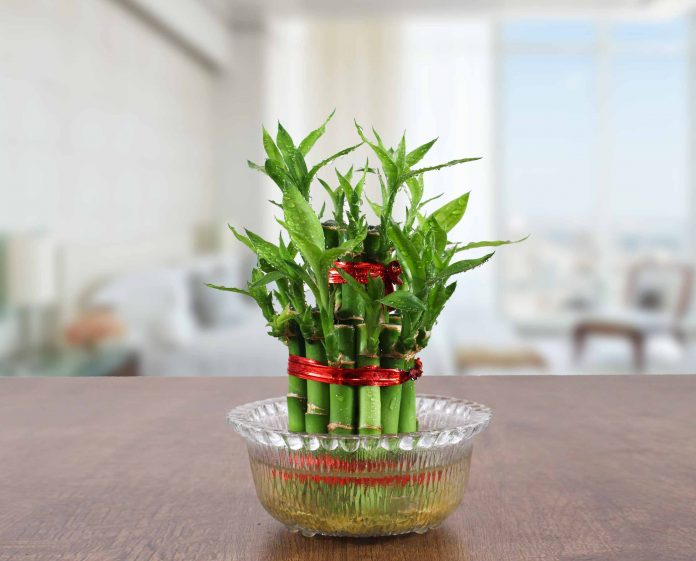
Introduction
Caring for lucky bamboo is a delicate process. The Lucky Bamboo plant is a household plant that is easy to care for and grows well in indirect sunlight. Many people think that it’s a real bamboo plant. But it is a type of tropical water lily called Dracaena sanderiana. The lucky bamboo plant is one of the most famous Feng Shui cures said to bring good luck and prosperity to the place where it is grown.
It is also known to enhance the flow of positive energy in the home and office when placed in the right direction. The lucky bamboo plant represents the element wood, and the red ribbon tied around it represents the element fire. It is known to create a sense of balance and safety in life.
Before getting into the Caring for lucky bamboo-step by step tutorial, let’s talk about what exactly is a Lucky Bamboo.
What is Lucky Bamboo?
The history of the lucky bamboo plant goes back to Chinese culture for over 4000 years. In the Asian culture, it symbolizes good fortune and is popular during celebrations like New Year and other religious festivals.
Significance
As per the Chinese tradition, the significance of lucky bamboo plants depends on how many stalks you have.
- Two stalks represent love, which is also said to double your luck.
- Three stalks represent wealth, happiness, and long life.
- Five stalks represent wealth that is perfect for giving to someone who desires growth in business.
- Six stalks symbolize luck that is said to bring prosperity.
- Seven stalks symbolize wealth, happiness, and good health.
- Eight stalks of the lucky bamboo plant act as a great motivator and luck enhancer.
- Nine stalks are considered the symbol of good fortune.
- Ten stalks represent completion and perfection.
- Twenty-one stalks represent abundance and blessings.
Some Common Shapes of Lucky Bamboo Plant
2 Layer Lucky Bamboo Plant
The 2-layer lucky bamboo plant belongs to the species Dracaena Sanderiana. It grows well in bright and filtered sunlight. Most of the 2-layer lucky bamboo plants are generally produced in the glass vase filled with pebbles and water, but they can also be potted in the well-aerated soil for the proper growth.

3 Layer Lucky Bamboo Plant
The scientific name for the 3-layer lucky bamboo plant is Dracaena braunii. It is also known by various other names, such as Friendship Bamboo, Curly Bamboo, Chinese Bamboo, and Chinese Water Bamboo. It is the most common indoor plant in different parts of the world, like India, China, and Taiwan. This is a low maintenance plant that can grow well, even in poor lighting conditions and adverse situations.
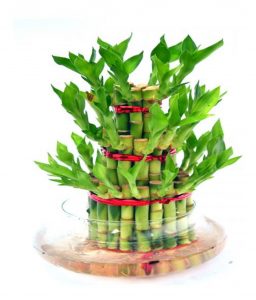
7 Layer Lucky Bamboo Plant
Elegant and easy to grow, the 7-layer lucky bamboo plant is a perfect gift for someone on professional and casual occasions. It ensures good fortune and brings serenity and calmness to your home and office. Considered the ideal indoor plant, it is advised to use filtered water for a 7-layer bamboo plant and change it every 7 days to prevent the roots from decaying.
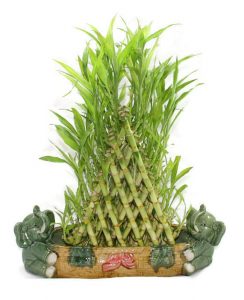
Caring for Lucky bamboo- Step by Step Tutorial
- Amount of water required- As with many plants, water is a balancing act with your bamboo. On the one hand, over-watering is probably the worst thing you can do to your bamboo; it will cause root rot. On the other hand, your bamboo needs adequate moisture, more than is usually provided by ambient indoor air.
Many people like to keep their bamboo in clear glass containers filled with pebbles and water. This is the right solution both because it’s attractive and because it provides a humid micro-environment for the bamboo plant.
Another way to make sure your bamboo is getting enough moisture is to mist it every couple of days. If you can turn a gentle fan onto it a few hours a week, it will also be delighted.
To know how much water your bamboo plant should have, keep an eye on its roots. Before your bamboo stalks have roots, they should be in one to three inches of water. After sources develop, make sure the bases are covered in water.
More about caring for lucky bamboo
Bamboo plants are susceptible to chemicals and salts in tap water. If you’re using tap water to water and mist your plant, leave the water out overnight to let the chlorine evaporate. Fluoride is incredibly challenging to get out of tap water, and bamboo plants don’t like it; it can cause leaf tips to turn brown. As an alternative to tap water, try using rainwater or distilled water.
Another important step for caring for lucky bamboo-step by step tutorial.
Thoroughly change your bamboo plant’s water every couple of weeks.

2. Soil type required- bamboo plants do not have to be planted in soil, but they can be if you prefer. Just make sure the soil drains well. Keep soil moderately moist—not soggy, and not desert dry. Don’t ever let your bamboo plant become water-logged.
3. Light required- Bamboo plants enjoy bright indirect light but can tolerate low light conditions, although they will grow more slowly. Ideal temperatures are in the 60 to 70-degree range, which isn’t a problem in most home or office conditions.
4. Fertilizer required- Bamboo plants can go for a long time with just water. However, they will benefit from a small drop of fertilizer added to their water when you give them fresh water.
If your bamboo plant is in soil, fertilize with a high-nitrogen, slow-release formula in the spring, according to manufacturer’s directions.
5. The right Container- Your pot should be about 2 inches (5 cm) more massive in diameter than the plant. Most Lucky Bamboo plants already come in a pool, but you can use your pot to make the plant more your own.
- A clear container works well for water and will show off your plant and pebbles, but make sure that you keep it out of direct sunlight.
- You can also use a ceramic pot and grow it in either pure water or in soil. If you use soil, plant the bamboo in a pot with a drain hole.
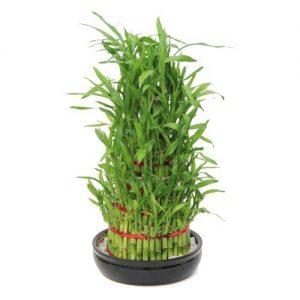
6. Propagating/styling the shoot for steady growth- If you wish to style the Lucky Bamboo plant, choose a few prime stalks to make a linked arrangement and put it on display. You can manipulate the stalks to grow around each other or curl with a bit of work; to do this, you have to use younger stalks that haven’t developed a lot and hardened yet.
- You can plant your stalks in a line or rows if you want straight stalks.
- To curl your Lucky Bamboo plant, get a cardboard box, and cut off the bottom and side. Place the container over your plant with the open end facing your light source. Your stalks will begin to curl towards the morning as they grow. Once you see a bend, rotate your plant.
- You can also wrap some wire around younger stalks crisscrossing them. As they grow, you will add more wire to keep them stable as they intertwine.
7. Removing dead/yellow leaves- Sometimes, the ends of your leaves might turn yellow. This could be caused by a few factors: your plant isn’t getting enough water, there’s too much soil or fertilizer, or too much direct sunlight. You can trim off the yellow parts, or remove the whole leaf. One of the most important steps for caring for lucky bamboo-step by step tutorial.
- To remove the yellowed tips of your leaves, sterilize a pair of pruning shears or sharp scissors and with light rubbing alcohol or vinegar, then cut the yellow part off following the natural shape of the leaf.
- You can remove whole leaves by simply pulling them down off the stalk at the base of the leaf.
8. Propagate properly- When one or two of your stalks gets too tall, you can cut them and replant them. This will help you care for your Lucky Bamboo plant by ensuring that it doesn’t get too crowded and can produce new plants.
- Take your most extended stalk and remove the smaller leaves at the top of the shoot.
- With a sterile knife or scissors, cut the shoot so at least two nodes, which are the raised part of the stem, are on the new cutting.
- Place the shoot in a bowl of clean, distilled water. Please keep it in a shady area for about one to two months until it begins to sprout roots. Once you see roots, you can replant it the same pot as your bamboo plant.
People often tie a gold or red ribbon around the stalks of Lucky Bamboo plants to hold them together, and as an extra symbol of good fortune.
- Add pebbles to finish off the look and hold the arrangement in place.
- Place your Lucky Bamboo plant somewhere where you will enjoy it and remind you to care for it.

9. Maintain an Ideal Temperature- The optimum temperature for a bamboo plant is between 65 to 90 degrees Fahrenheit. Lucky bamboo plants may not survive in temperatures below 55 degrees Fahrenheit so never place it in front of an air conditioner. Avoid both direct sunlight and extreme temperature. Never place your plant near a heat source such as a heating vent or wood stove.
10. Provide Humidity- If it’s particularly dry, consider spritzing your bamboo leaves with a little distilled water occasionally to keep the environment more humid.
Lucky Bamboo Problems and precautions
Lucky bamboo problems occur for a number of reasons; take precautions to prevent and fix any issues that arise while caring for your plant. From algae to the wrong water, learn how to combat the problems which can take hold in your plant in a variety of ways.
Too Much Light
Firstly, lucky bamboo is generally grows hydroponically at nurseries and greenhouses, most people keep their bamboo in a vase of water and pebbles when they bring it home. The type of vase your lucky bamboo lives in makes a huge difference as to whether or not it develops an algae problem. Clear vases expose the water in the vase to too much light. The light reacts with the algae spores, causing them to bloom or grow.
Too Little Light
Secondly, too much light can cause algae growth, not enough light can cause your bamboo to fade in color. While you need to keep your bamboo is an opaque vase, you also need to ensure it gets plenty of indirect light, meaning it can be near, but not in, a window.
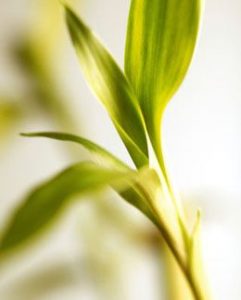
Too Many Nutrients
Thirdly, algae also thrive in nutrient-rich water. Phosphates and nitrates are a favorite food source of algae. Many plant foods contain both nitrates and phosphates; overfeeding your lucky bamboo could be the cause of your algae problem, in addition to the yellowing of the leaves.
Wrong Water
Lastly, if your bamboo is suddenly showing yellowing leaves, this could be caused by using the wrong water. Tap water is full of things like chlorine and fluoride, which can cause your bamboo to begin to yellow or turn brown. Using distilled or filtered water will prevent this yellowing from occurring.
If you must use tap water and you know it has high levels of chlorine, keep it in a container on the counter for 24 hours before using it. This allows time for the chlorine in the water to evaporate. If your water is high in fluoride levels do not use it for your plant. Fluoride will cause your lucky bamboo to turn brown and it does not evaporate.
Keep this in mind while caring for lucky bamboo-step by step tutorial.

Solutions
If you already have some problems with your bamboo, try these solutions:
- Change the vase: If you don’t have another vase handy, simply take the bamboo out of its vase, then wash the vase with warm water and a tiny bit of mild soap. Be sure to rinse thoroughly. Then add the bamboo back to the clean vase.
- Change the water frequently: Remember to use distilled or filtered water.
- Move the plant: If the bamboo is in a spot with lot of direct sunlight, which encourages algae growth, moves the plant to an area that receives indirect sunlight. If your plant is not growing well or has begun to fade in color, move it to another source of indirect light instead.
Epilogue
If you take care of your bamboo plant it attracts positive energy. Following the above-mentioned caring for lucky bamboo-step by step tutorial will help.